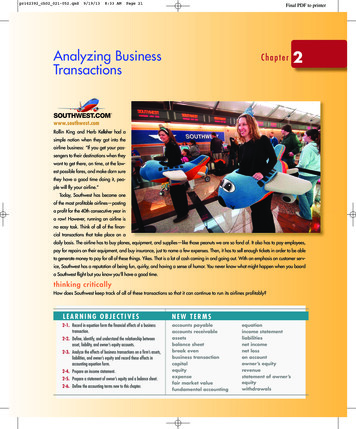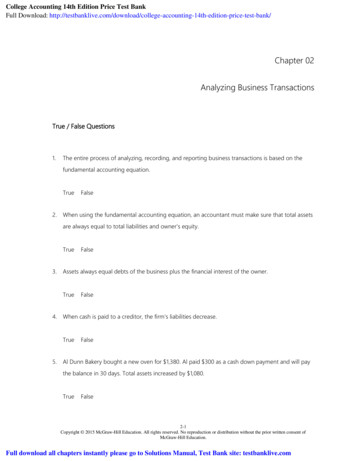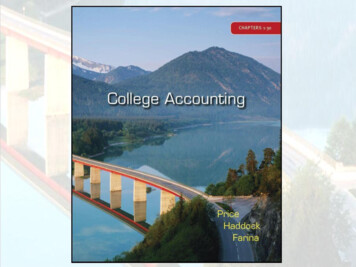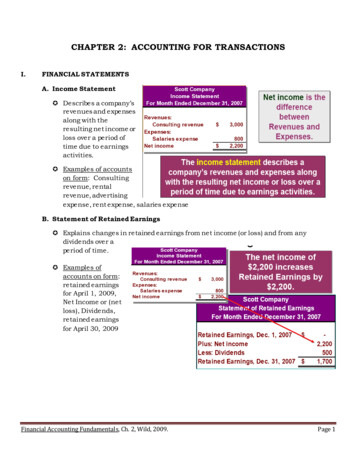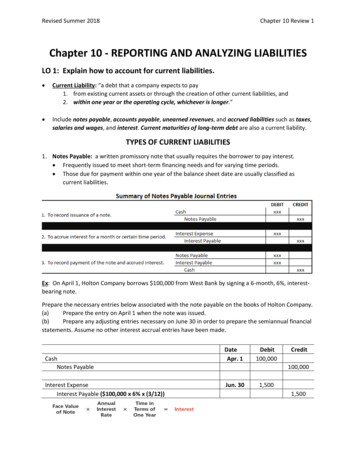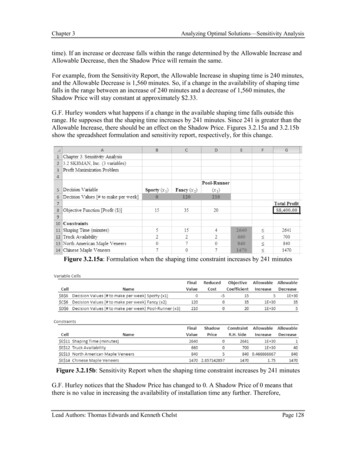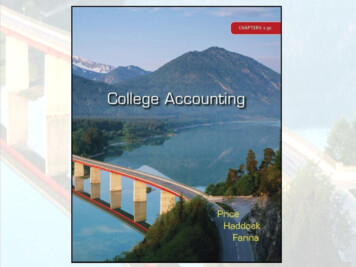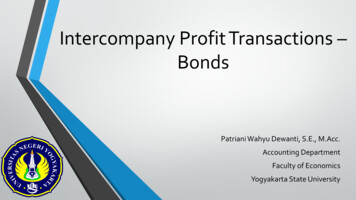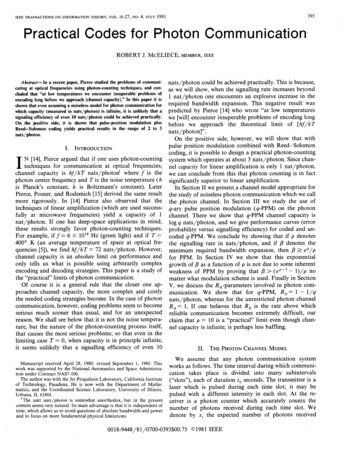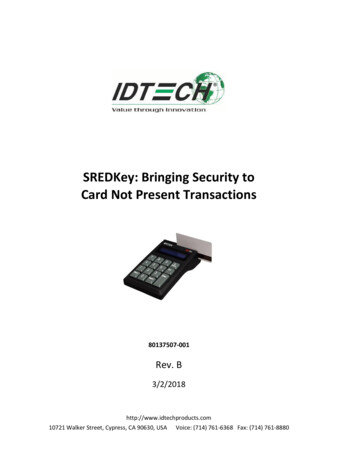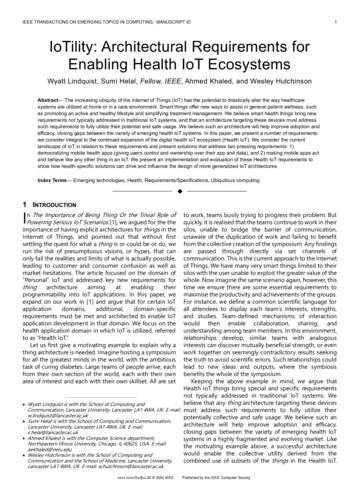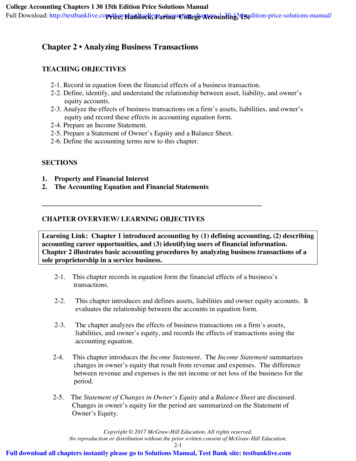
Transcription
College Accounting Chapters 1 30 15th Edition Price Solutions ManualFull Download: l/Price, Haddock, Farina College Accounting, 15eChapter 2 Analyzing Business TransactionsTEACHING OBJECTIVES2-1. Record in equation form the financial effects of a business transaction.2-2. Define, identify, and understand the relationship between asset, liability, and owner’sequity accounts.2-3. Analyze the effects of business transactions on a firm’s assets, liabilities, and owner’sequity and record these effects in accounting equation form.2-4. Prepare an Income Statement.2-5. Prepare a Statement of Owner’s Equity and a Balance Sheet.2-6. Define the accounting terms new to this chapter.SECTIONS1.2.Property and Financial InterestThe Accounting Equation and Financial StatementsCHAPTER OVERVIEW/ LEARNING OBJECTIVESLearning Link: Chapter 1 introduced accounting by (1) defining accounting, (2) describingaccounting career opportunities, and (3) identifying users of financial information.Chapter 2 illustrates basic accounting procedures by analyzing business transactions of asole proprietorship in a service business.2-1.This chapter records in equation form the financial effects of a business’stransactions.2-2.This chapter introduces and defines assets, liabilities and owner equity accounts. Itevaluates the relationship between the accounts in equation form.2-3.The chapter analyzes the effects of business transactions on a firm’s assets,liabilities, and owner’s equity, and records the effects of transactions using theaccounting equation.2-4.This chapter introduces the Income Statement. The Income Statement summarizeschanges in owner’s equity that result from revenue and expenses. The differencebetween revenue and expenses is the net income or net loss of the business for theperiod.2-5.The Statement of Changes in Owner’s Equity and a Balance Sheet are discussed.Changes in owner’s equity for the period are summarized on the Statement ofOwner’s Equity.Copyright 2017 McGraw-Hill Education. All rights reserved.No reproduction or distribution without the prior written consent of McGraw-Hill Education.2-1Full download all chapters instantly please go to Solutions Manual, Test Bank site: testbanklive.com
Price, Haddock, Farina College Accounting, 15e2-6.The Balance Sheet shows assets, liabilities, and owner’s equity on a given date.Copyright 2017 McGraw-Hill Education. All rights reserved.No reproduction or distribution without the prior written consent of McGraw-Hill Education.2-2
Chapter Opener: Thinking CriticallyAt the beginning of the chapter, there is a short paragraph about SouthwestAirlines. Let’s read this together. . .Ask students “How does Southwest keep track of all of these transactionsso that it can continue to run its airline profitability?”Answer--- The individuals in charge of keeping track of thesetransactions at Southwest as well as in other companies, are knownas accountants. When recording the transactions, accountants arerequired to follow a set of rules and regulations known as GAAP.For every financial transaction that Southwest has, their accountantsdetermine the accounts that were affected and then they record,report, and then analyze these transactions. By doing so they can, ata specific point in time and over a stipulated period, be able to assessthe company’s financial performance including profitability of theairline, assets owned by the company, and of course the amountowed to creditors and owners.Copyright 2017 McGraw-Hill Education. All rights reserved.No reproduction or distribution without the prior written consent of McGraw-Hill Education.2-3
Section 1. PROPERTY AND FINANCIAL INTERESTBeginning with AnalysisAsk students, “What happens when you buy a pair of jeans and paycash?”---The total cost of jeans they own increases, and the amountof cash they have decreases.Ask students, “What happens when you buy a pair of jeans with yourcredit card?”—The total they own increases, and the amount ofmoney they owe increases. Point out that most business transactions have at least two effects.Objective 2-1 Starting a Business Explain that the equation, property financial interest, is thebasis for transaction analysis. DESCRIBE THESE ANALYSIS STEPS:1. Explain to students that analysis (determining whether afinancial event, like a purchase, sale, payment, or receipt isa business transaction) is the first step of the recordingprocess.2. The equation must always be in balance. Purchasing Equipment for Cash Remind students that, when recording the effects oftransactions in equation form, the value of property acquired bya business is offset by any claim against the property (rights toproceeds from a sale of property).Copyright 2017 McGraw-Hill Education. All rights reserved.No reproduction or distribution without the prior written consent of McGraw-Hill Education.2-4
Emphasize that a claim is never asset specific. That is, assetsare thought of as being a pool of items. Purchasing Equipment on Credit Define Accounts Payable. (Amounts that a business must payin the future.) Explain that purchasing an asset on credit:1. Increases the asset—the Property side of the equation.2. Increases the amount owed by the business—the FinancialInterest side of the equation. Point out that the equation must alwaysremain in balance. Purchasing Supplies Explain that this transaction :1. Increases the asset, Supplies.2. Decreases the asset, Cash. Point out that the equation remains in balance. Paying A Creditor Explain that paying a creditor involves:1. A decrease in the amount owed by the business—theFinancial interest side of the equation.2. A decrease in cash—the Property side of the equation. Point out that the equation remains in balance. Renting Facilities Point out that the rent in this transaction is paid in advance. Explain that the right to occupy the facility is considered a formof property.Copyright 2017 McGraw-Hill Education. All rights reserved.No reproduction or distribution without the prior written consent of McGraw-Hill Education.2-5
Explain that this transaction:1. Increases the asset, Prepaid Rent.2. Decreases the asset, Cash. Point out that the equation remains in balance.Objective 2-2Assets, Liabilities, and Owner’s EquitySay to your students, “Suppose you want to establish a CateringService business. What items will you need to start the business?”--List these on the board.Then ask students, “How will you acquire these items?” List theresponses on the board. Explain to students that everything listed will be categorized as anasset or a liability. The difference is owner’s equity. Have students categorize the items.Objective 2-3Section 2. THE ACCOUNTING EQUATIONAND FINANCIAL STATEMENTSThe Fundamental Accounting EquationWrite the accounting equation on the board, then Explain to students that accountants show the relationshipbetween assets, liabilities, and owner’s equity in an equation.Copyright 2017 McGraw-Hill Education. All rights reserved.No reproduction or distribution without the prior written consent of McGraw-Hill Education.2-6
Assets are on the left and liabilities and owner’s equity (claimsagainst the assets), are on the right. The two sides of the equation must always balance. Emphasize that assets are things that an individual or a businessowns that have value.Ask students to give you examples of assets. As they yell them out,write the assets under Assets in the accounting equation. Do the samething with examples of Liabilities. Earning Revenue and Incurring Expenses Explain that revenue is the inflow of assets (cash or accountsreceivable) as a result of the sale of goods or services. Explain that expenses are the costs associated with earningrevenue. In the beginning, students might get confused by the termsexpense and liability. Point out that an expense is something that was used up andcan actually create a liability if it is not paid off in cash. Aliability is a debt owned by the business and usually ends withthe word “payable”—Accounts Payable is a good example.Copyright 2017 McGraw-Hill Education. All rights reserved.No reproduction or distribution without the prior written consent of McGraw-Hill Education.2-7
Selling Services for Cash Explain that this transaction:1. Increases the asset, Cash.2. Increases the revenue. Point out that the equation remains in balance. Point out that revenues are recorded in a separate columnunder owner’s equity. Selling Services on CreditAsk students, “Why can we record this transaction as revenue eventhough we haven’t got paid yet?” —because we have earned it. Collecting ReceivablesAsk students, “Why don’t we record revenue when we receive thispayment?” —because we would be recording the revenue twice. Paying Employees Salaries Point out that expenses are recorded in a separate columnunder owner’s equity. Explain that expenses have the effect of decreasing owner’sequity. Emphasize that this transaction:1. Decreases the asset, Cash.2. Increases the Expenses column which causes Owner’sEquity to go down. Point out that the equation remains in balance. Paying Utilities Expense Explain that this transaction:1. Decreases the asset, Cash.Copyright 2017 McGraw-Hill Education. All rights reserved.No reproduction or distribution without the prior written consent of McGraw-Hill Education.2-8
2. Increases the Expenses column which causes Owner’sEquity to go down. Point out that the equation remains in balance. Effects of Owner’s Withdrawals Explain that the funds taken from the business are for theowner’s personal use and not an expense of the business, buta decrease in owner’s equity. In accounting, owner’s equity is the amount remaining after thevalue of all liabilities is subtracted from the value of all assets.That is, it is the owner’s right to the financial interest in thebusiness.Point out to students the Summary of Transactions Figure 2-2in the text. After recording all of these transactions, the accountingequation still balances.Objective 2-4The Income StatementExplain to students that the Income Statement is the first in aseries of three reports that together, provide a business owner withall of the business’s financial information. Point out that the income statement details revenues andexpenses. It reports whether the business had a “net income”or a “net loss.”Ask students, “When would a business report a net loss?” (Whenexpenses are greater than revenues.)Copyright 2017 McGraw-Hill Education. All rights reserved.No reproduction or distribution without the prior written consent of McGraw-Hill Education.2-9
Explain that the heading of the Income Statement includes theappropriate three-line heading:Who— Name of the companyWhat— Name of the financial statementWhen—Period of time coveredObjective 2-5Statement of Owner’s Equity and the BalanceSheetThe Statement of Owner’s Equity reports the changes that occurredin the owner’s financial interest during the reporting period. It would include:1. Investments2. Net income or net loss of the business3. Any withdrawals the owner made Point out the three-line heading. Emphasize the importance of including the beginning capitalbalance and the ending capital balance.The Balance Sheet shows: Point out that the Balance Sheet contains information aboutassets, liabilities, and the balance in the owner’s equityaccount. It points out the equality of the Accounting Equation.Ask students, “What is the difference in the heading of the statement?”—the date line.Copyright 2017 McGraw-Hill Education. All rights reserved.No reproduction or distribution without the prior written consent of McGraw-Hill Education.2-10
Explain that The Income Statement and the Statement ofOwner’s Equity are a movie covering a period of time but theBalance Sheet is a snapshot at a specific moment.The Importance of Financial StatementsAsk students, “Where could I find information about whether a firm ismaking a profit?”—(The Income Statement).Ask students, “Which statement contains information about the assetsowned or amounts owed by the business?”—(The Balance Sheet).Ask students, “Which statement would provide information about howmuch the owner invested or withdrew during the period?”—(TheStatement of Owner’s Equity).Financial statements and other records are necessary so that businesspeople can make good decisions. . .Managerial Implications:Ask students, “If you were buying a business, what would you look forin the company’s financial statements?”Answer—Answers will vary. Students should mention total assetsand the type of assets, the liabilities, the business would beresponsible for, and whether the business is making a profit. Point out the sequence/order in which the financial statementsmust be prepared:1st—income statement2nd—statement of owner’s equity3rd—balance sheetCopyright 2017 McGraw-Hill Education. All rights reserved.No reproduction or distribution without the prior written consent of McGraw-Hill Education.2-11
.Copyright 2017 McGraw-Hill Education. All rights reserved. No reproduction or distribution without the prior written consent of McGraw-Hill Education
Chapter 2Analyzing BusinessTransactionsbyPrice, Haddock and Farina.Copyright 2017 McGraw-Hill Education. All rights reserved. No reproduction or distribution without the prior written consent of McGraw-Hill Education2-2
Chapter 2 Learning ObjectivesSECTION 1: Property and Financial Interests2-1 Record in equation form the financial effects of a businesstransaction.2-2 Define, identify, and understand the relationship betweenasset, liability, and owner’s equity accounts.SECTION 2: The Accounting Equation and Financial Statements2-3 Analyze the effects of business transactions on a firm’sassets, liabilities, and owner’s equity and record theseeffects in accounting equation form.2-4 Prepare an income statement.2-5 Prepare a statement of owner’s equity and a balance sheet.2-6 Define the accounting terms new to this chapter.Copyright 2017 McGraw-Hill Education. All rights reserved. No reproduction or distribution without the prior written consent of McGraw-Hill Education2-3
Meet Eli’s Consulting Services Eli’s Consulting Services is a firm that provides a wide range ofaccounting and consulting services. Trayton Eli, CPA is the sole proprietor of the firm.Carlos Valdez is the office manager of the firm. Every month the firm bills clients for the services provided thatmonth. Customers can also pay in cash when the services areprovided.Copyright 2017 McGraw-Hill Education. All rights reserved. No reproduction or distribution without the prior written consent of McGraw-Hill Education2-4
Steps to analyze the effect of abusiness transaction1. Describe the financial event. Identify the property.Identify who owns the property.Determine the amount of increase or decrease.2. Make sure the equation is in balance.Property (asset) Financial Interest(creditors and owners).Copyright 2017 McGraw-Hill Education. All rights reserved. No reproduction or distribution without the prior written consent of McGraw-Hill Education2-5
Section 1: Property and Financial InterestsLearning Objective2-1: Record in equation form thefinancial effects of a businesstransaction.Copyright 2017 McGraw-Hill Education. All rights reserved. No reproduction or distribution without the prior written consent of McGraw-Hill Education2-6
Section 1, Objective 2-1: Record in equation form the financial effects of a business transaction.Business TransactionTrayton Eli withdrew 100,000 from personalsavings and deposited it in a new checking accountin the name of Eli’s Consulting Services.Analysis:(a) The business received 100,000 of property in theform of cash.(a) Eli has a 100,000 financial interest in the business.Copyright 2017 McGraw-Hill Education. All rights reserved. No reproduction or distribution without the prior written consent of McGraw-Hill Education2-7
Section 1, Objective 2-1: Record in equation form the financial effects of a business transaction.The owner invested cash into the businessTrayton Eli now has 100,000 equity in Eli’sConsulting Services.Copyright 2017 McGraw-Hill Education. All rights reserved. No reproduction or distribution without the prior written consent of McGraw-Hill Education2-8
Section 1, Objective 2-1: Record in equation form the financial effects of a business transaction.The company buys equipment for 5,000 cash 100,000 100,000.Copyright 2017 McGraw-Hill Education. All rights reserved. No reproduction or distribution without the prior written consent of McGraw-Hill Education2-9
Section 1, Objective 2-1: Record in equation form the financial effects of a business transaction.The company buys 6,000 of equipmenton account (on credit) 106,000 106,000Notice the new claim against the firm’sproperty – the creditor’s claim of 6,000.Copyright 2017 McGraw-Hill Education. All rights reserved. No reproduction or distribution without the prior written consent of McGraw-Hill Education2-10
Section 1, Objective 2-1: Record in equation form the financial effects of a business transaction.The firm purchases supplies for 1,500 cash 106,000 106,000.Copyright 2017 McGraw-Hill Education. All rights reserved. No reproduction or distribution without the prior written consent of McGraw-Hill Education2-11
Section 1, Objective 2-1: Record in equation form the financial effects of a business transaction.The firm makes a payment of 2,500 on account 103,500 103,500.Copyright 2017 McGraw-Hill Education. All rights reserved. No reproduction or distribution without the prior written consent of McGraw-Hill Education2-12
Section 1, Objective 2-1: Record in equation form the financial effects of a business transaction.The firm makes a payment of 8,000 rentin advance 103,500 103,500.Copyright 2017 McGraw-Hill Education. All rights reserved. No reproduction or distribution without the prior written consent of McGraw-Hill Education2-13
Section 1: Property and Financial InterestsLearning Objective2-2: Define, identify, andunderstand the relationshipbetween asset, liability, andowner’s equity accounts.Copyright 2017 McGraw-Hill Education. All rights reserved. No reproduction or distribution without the prior written consent of McGraw-Hill Education2-14
Section 1, Objective 2-2: Define, identify, and understand the relationship between asset, liability, and owner’s equityaccounts.Assets, Liabilities,and Owner’s EquityQUESTION:What are assets?ANSWER:Assets are property owned by abusiness.Copyright 2017 McGraw-Hill Education. All rights reserved. No reproduction or distribution without the prior written consent of McGraw-Hill Education2-15
Section 1, Objective 2-2: Define, identify, and understand the relationship between asset, liability, and owner’s equityaccounts.Liabilities and EquityQUESTION:What are liabilities?ANSWER:Liabilities are debts or obligations of abusinessQUESTION:What is owner’s equity?ANSWER:Owner’s equity is the term used by soleproprietorships. It is the financial interest ofan owner of a business. It is also calledproprietorship or net worth.Copyright 2017 McGraw-Hill Education. All rights reserved. No reproduction or distribution without the prior written consent of McGraw-Hill Education2-16
Section 1, Objective 2-2: Define, identify, and understand the relationship between asset, liability, and owner’s equityaccounts.The Balance SheetQUESTION:What is a Balance Sheet?ANSWER:A balance sheet is a formal report of thefinancial position of a business on acertain date. It reports the assets,liabilities, and owner’s equity of thebusiness.Copyright 2017 McGraw-Hill Education. All rights reserved. No reproduction or distribution without the prior written consent of
Chapter 2 illustrates basic accounting procedures by analyzing business transactions of a sole proprietorship in a service business. 2-1. This chapter records in equation form the financial effects of a business’s transactions. 2-2. This
